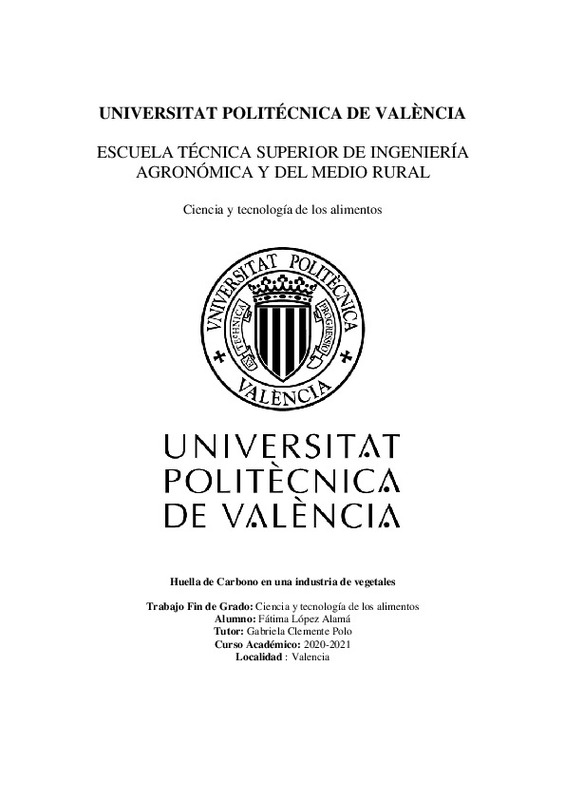|
Resumen:
|
[ES] La emergencia climática es una de las principales problemáticas a las que la sociedad del siglo XXI debe hacer frente. Aunque las causas de esta crisis son diversas, se estima que un porcentaje no despreciable de las ...[+]
[ES] La emergencia climática es una de las principales problemáticas a las que la sociedad del siglo XXI debe hacer frente. Aunque las causas de esta crisis son diversas, se estima que un porcentaje no despreciable de las emisiones de gases de efecto invernadero son responsabilidad del actual sistema alimentario. Hay muchas variables que afectan a la sostenibilidad de un determinado alimento: producción de las materias primas, nivel y tipo de procesado, material de envasado, distribución del producto… Es posible conocer de manera cuantitativa los gases de efecto invernadero asociados a cada uno de estos procesos, gracias al cálculo de la huella de carbono, que es uno de los principales parámetros con los que las empresas estiman su impacto medioambiental. Así, el presente trabajo se centrará en evaluar la huella de carbono de una de las tipologías de alimentos más populares: las verduras ultracongeladas. Con este fin, en primer lugar, se elaborará un diagrama de flujo con las etapas que conforman cada línea de producción de las tres verduras seleccionadas: guisantes, espinacas y judías verdes. Esto permitirá establecer la maquinaria y los consumos energéticos necesarios para transformar los productos frescos en ultracongelados. Una vez conocidos estos consumos y siguiendo las directrices establecidas en la Guía para el cálculo de la Huella de Carbono y para la elaboración de un plan de mejora de una organización, publicada por el Ministerio para la Transición Ecológica, se calculará la huella de carbono asociada a cada proceso productivo. Posteriormente, se procederá a comparar los valores obtenidos con productos análogos a las verduras ultracongeladas consideradas, por ejemplo, guisantes en conserva o espinacas de cuarta gama. De esta manera, se podrá establecer qué tipo de procesado representa un mayor impacto sobre el medio ambiente. Por último, se propondrán una serie de recomendaciones o mejoras con el objetivo de promover prácticas más sostenibles en las industrias de verduras ultracongeladas.
[-]
[EN] Weather emergency is one of the main problems that 21st century must face. Although the causes of this crisis are diverse, it is estimated that a non-negligible percentage of greenhouse gas emissions are due to the ...[+]
[EN] Weather emergency is one of the main problems that 21st century must face. Although the causes of this crisis are diverse, it is estimated that a non-negligible percentage of greenhouse gas emissions are due to the current food system. Thera are many variables that affect food sustainability, as the production of raw materials, the level and type of processing, the packaging material, the product distribution, … It is possible to quantitatively know the greenhouse gases associates with each of these processes, thanks to the calculation of the carbon footprint. The carbon footprint is one of the main parameters with which companies estimate their environmental impact. This project will focus on evaluating the carbon footprint of one of the most popular types of food: deep-frozen vegetables. To this end, first, a flow chart will be drawn up with the stages that make up each production line of the three selected vegetables: peas, spinach, and green beans. This will make it possible to establish the machinery and energy consumption necessary to transform fresh products into deep-frozen ones. Once these consumptions are known and following the guidelines established in the Guide for the calculation of the Carbon Footprint and for the elaboration of an improvement plan of an organization, published by the Ministry for the Ecological Transition, the associated carbon footprint will be calculated to each production process. Subsequently, the values obtained will be compared with products like the deep-frozen vegetables considered, for example, canned peas or fourth-range spinach. In this way, it will be possible to establish what type of processing represents a greater impact on the environment. Finally, a series of recommendations or improvements will be proposed with the aim of promoting more sustainable practices in the frozen vegetable industries.
[-]
|







